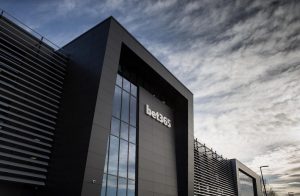Ryanair enjoys sky high profits

LOW cost airline Ryanair has reported a trebling of its annual profits to €319m (£289m) after tax – a rise of 204% on last year’s figure of €105m.
The airline, which operates a number of routes out of Birmingham International Airport, saw fares fall 13% in the year to March 31 but this was compensated for with a 14% rise in passenger numbers to 67 million.
The company also benefited from lower oil costs and a cost reduction strategy. However, it has warned that the disruption from the volcanic ash cloud is expected to hit first quarter profits.
Ryanair said it was also proposing to pay a one-off dividend of €500m (€0.34 per share) in October, subject to shareholder approval at the company’s AGM in September.
Revenue for the full year was €2.99bn, a 2% increase on last year’s €2.94bn.
Announcing the results Ryanair’s chief executive Michael O’Leary, said in addition to profits and traffic growth, the airline had acquired 51 new aircraft and had set up new bases in Bari, Brindisi, Faro, Leeds, Oslo Rygge, Pescara, Porto and Trapani, bring its total to 42.
It has introduced 284 new routes, bringing its total number of services to 940.
“We can be proud of delivering a 200% increase in profits and traffic growth during a global recession when many of our competitors have announced losses or cutbacks,” said Mr O’Leary.
Unit costs fell 19% due to lower fuel and rigorous cost control. Ancillary sales grew 11% to €664m slightly slower than traffic growth, and amounted to 22% of total revenues.
Fuel costs declined 29% to €894m as oil prices fell from $104 to $62 per barrel.
The airline said it had extended its fuel hedging to 90% for FY11 (at $730 per tonne), 50% of Q1 FY12 (at $750 per tonne) and 20% of Q2 FY12 (at $750 per tonne). Excluding fuel other unit costs fell by 3%.
The airline said capacity cuts by many European flag and non-flag carriers caused traffic to fall at many major European airports. This resulted in the firm being inundated with offers from large and small airports competing with lower costs and efficient facilities to win Ryanair’s business.
It said airport and handling unit costs fell by 9% despite steep increases at Dublin and Stansted, while the new routes and bases launched this year would ensure that despite increases of up to 40% at some airports, its unit costs would again fall next year.
The company’s cash balances have strengthened, rising from €535m to €2.8bn, as it looked to take advantage of recent historically low rates to lock in many of its 2009/2010 deliveries at an all inclusive long term interest cost of under 4%.
It is now fully financed for the remaining 34 deliveries out to January 2011, meaning it will be able to purchase aircraft during 2010/11 at low cost.
Of current issues the airline said it had been hit by the decline of the Irish economy, while the recent disruption caused by the volcanic ash cloud led to 9,400 of its flights being cancelled – resulting in the loss of 1.5m passengers to May 18.
The airline has estimated the cost of the disruption to be around €50m and the figures are expected to be reflected in next year’s results.
Looking ahead, the airline has said it expects traffic growth of 11% next year to 73.5m, while fuel costs are likely to increase by €300m.
However, it said subject to no further air space closures and an early return to normal bookings, it expected airfares – which fell 13% last year – to rise by between 5% to 10%. This is mainly due to the positive impact of the new routes and bases.
Some of the new services, such as Faro and Malaga, are already producing higher fares.
Despite the optimism, the airline has added a note of caution saying that first quarter profits are likely to be hit by weaker yields in May and June due to the volcanic ash disruptions, and the inclusion of part of Easter revenues in the prior period.
Overall it said it expected costs per passenger to rise by 4% in 2010/11.
“If as we expect, higher yields offset increased fuel and other operating costs, then profits (excluding exceptional costs from the recent volcanic ash disruptions) for the coming year should rise by between 10% to 15% to a range of approximately €350m to €375m,” it said.






